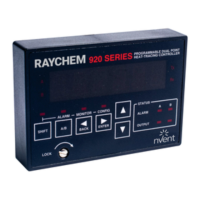19 / 82
EN- Raychem920series-IM-H5687405/15
INDUSTRIAL HEAT TRACING SOLUTIONS
3.3 920 OPERATOR CONSOLE DISPLAY
The optional 920 Operator Console provides a menu-driven, alphanumeric interface to
ease configuration and troubleshooting. The following features are part of the controller’s
programming, but are only used in conjunction with the 920 Operator Console. For a detailed
description of each of the console features and operating instructions, refer to the separate
Raychem 920 Series HTC Operator Console—Installation and Operating Instructions
(Pentair
Thermal Managament reference H56903).
3.4 920 FUNCTIONS
The sections that follow explain the various functions of the 920 controller and how they can be
accessed. The first line of each section identifies the function to be described. Each section goes
on to explain the Purpose of the function, the Range over which it may be set, the Procedure for
setting or enabling the feature, and finally any Notes or Cautions that pertain to the particular
function.
Setting and using the alarming functions of the 920 controller is a two step procedure:
1. The alarm must be enabled or disabled accordingly. When using the 920 Operator Console,
access to all alarming functions is available using the CONFIGURE mode sub-menus. When
using the Model 780/GCC-9000 Group Communications Controller, the alarm masks may be
found in the HTC SETUP Section. Please see the appropriate operating manual for instructions
on accessing these parameters.
2. The corresponding alarm point value may be modified appropriately for the application.
When using the 920 Operator Console, access to the alarm points is also available using the
CONFIGURE mode sub-menus. Modification of the alarm setpoint values is found in the HTC
SETPOINTS Section of the Model 780/GCC-9000 Group Communications Controller. Please see
the appropriate operating manual for in-structions on accessing this feature.
IMPORTANT: The 920 Operator Console or the Model 780/GCC-9000 will
not
allow modification
of an alarm point value if the alarm has been disabled (DIS) with the exception of the HIGH TS
ALARM temperature settings. These may still be modified if the corresponding HIGH LIMIT
CUTOUT has been enabled (ENA).
3.5 CONTROL POINT SETUP
This Section describes the setup parameters that relate to a specific control point—either Point A
or Point B. These parameters must be configured for each of the two control points that are used.
3.5.1 CONTROL SETPOINT TEMPERATURE
Purpose: The CONTROL SETPOINT temperature is the value at which the heat trace controller
maintains the circuit temperature through either proportional, proportional ambient SSR,
proportional ambient contactor, or deadband control, depending on the controllers’ configuration.
The CONTROL SETPOINT temperature is compared to the temperature measured by the control
temperature sensor (TS). A decision is then made to turn on or turn off the output to control power
to the tracer.
Range: –76°F to 1058°F (–60°C to 570°C)
Procedure: Adjust the CONTROL SETPOINT temperature value to the desired maintain
temperature. The HTC will switch the output ON and OFF in an attempt to maintain this
temperature.
IMPORTANT:
• Seesection5.2onpage50ofthismanualforanexplanationofProportional,Proportional
Ambient SSR, Proportional Ambient Contactor and Deadband Control algorithms.
• Whenusinganoptional920OperatorConsole(forV3.11andup)theCONTROLSETPOINT
temperature range may be limited to the CON-SOLE SETPOINT MAXIMUM and MINIMUM
values (see sections 3.5.29 on page 29 and 3.5.30 on page 29). This is a safety feature to pre-
vent users in the field from modifying the CONTROL SETPOINT temperature setting to a
dangerous level.

